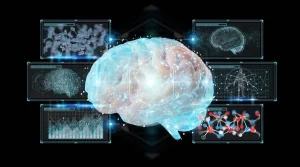

CEBRA: An AI That Accurately Converts Brain Signals to Video
source link: https://www.analyticsvidhya.com/blog/2023/05/cebra-ai-accurately-guesses-video-watched-by-subject-from-brain-signals/
Go to the source link to view the article. You can view the picture content, updated content and better typesetting reading experience. If the link is broken, please click the button below to view the snapshot at that time.

In a ground-breaking research study published by Nature, artificial intelligence (AI) can now translate brain signals into video with significant accuracy. The AI model, named CEBRA, was developed by scientists from École Polytechnique Fédérale de Lausanne (EPFL). The possibilities of this discovery are enormous and could revolutionize our understanding of the brain using AI technology.

The Study Design
In order to predict zebra movement, the study involved entering data from a mouse’s brain and a video. Scientists recorded the rodents’ brain activity using electrode probes inserted into their visual cortex region. They also employed optical probes on genetically modified mice. The brains of these mice were engineered to light up green while firing and transmitting information.

The real-time brain activity of mice watching films was used by the researchers to train CEBRA. With the help of this information, CEBRA discovered which brain impulses correspond to which movie frames. Using this knowledge, a mouse watching a slightly different sample of the movie clip provided the machine-learning system with some fresh brain activity it had never seen before.
The researchers created a film out of the new data, which allowed CEBRA to guess which frame the mouse had been watching in real time. The reconstructed footage was almost identical to the original movie clip.
Also Read: ML Used to Decode How Brain Interprets Different Sounds
The Results
The researchers explain how a mouse was exposed to a 1960s black-and-white film footage of a guy running to a car and opening the trunk in a video posted by EPFL. A different screen displays what CEBRA believes the mouse is viewing, and the AI’s reconstruction of the scene is nearly identical, despite some sporadic video jerkiness.

It is not the first time that scientists have used decoding to create images from brain impulses. Using the well-known Stable Diffusion model, researchers at Osaka University in Japan were able to reconstruct high-resolution and extremely accurate images from brain activity last month.
Also Read: AI Model That Can Translate Brain Activity into Text
The Potential of CEBRA
The development of CEBRA is a significant leap forward in our understanding of the human and animal brain. This technology has enormous potential to help researchers study how the brain processes visual information, leading to breakthroughs in neuroscience.
Future applications of this research are literally mind-boggling. For instance, people with motor neuron diseases or paralysis may be able to control machines just by thinking about it. The technology could also provide new insights into brain disorders like epilepsy, Parkinson’s disease, and Alzheimer’s.
Also Read: ‘AI Can Never Beat Human Mind’ – Infosys Co-founder Narayan Murthy
Our Say
The development of CEBRA and its ability to translate brain signals into video with significant accuracy is a remarkable achievement in AI technology. This AI model will undoubtedly change the way we approach the study of the brain. It opens up possibilities beyond our present imagination and provides a foundation for future research that could pave the way for new treatments for debilitating brain conditions. With further study, we can anticipate groundbreaking discoveries that will transform medicine and science as we know it.
Related
Recommend
-
 27
27
We all want to make faster websites. The question is just what to measure, and how to use that information to determine what’s “slow” and what could be made faster. The browser rendering pipeline is complicated....
-
 8
8
Mar 19 / by Dan RobitzskiDARPA Is Funding Nanoparticles That Permeate Brain to Read Neural SignalsThe military already wants them for new brain-computer interfa...
-
 5
5
Oscilloscoping Video SignalsOscilloscoping Video Signals The image on the left is a simple static image that I was able to output as a video signal (NTSC-M). I attached an oscilloscope to the video output, and recorded an image...
-
 4
4
Meta’s new Make-a-Video signals the next generative AI evolution
-
 13
13
Facebook Launching New In-App Browser For Android Facebook's new in-app browser on Android is said to be more stable, with enhanced performance and security...
-
 7
7
Research News Brain circuit that converts spatial goals to escape actions discovered 21 December 2022...
-
 2
2
Next-gen TV: LG's 97-inch Signature OLED receives all audio and video signals wirelessly All we need now is wireless power By
-
 1
1
PiEEG is a Raspberry Pi-powered crowdfunding project to read brain bio-signals Making neuroscience accessible to everyone thanks to Raspberry Pi By
-
 5
5
Science & Tech The Air Force Is Rebuilding Its Pacific Plans Around the B-21 ...
-
 6
6
Researchers treat depression by reversing brain signals traveling the wrong way share...
About Joyk
Aggregate valuable and interesting links.
Joyk means Joy of geeK